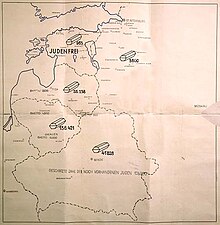Kaunas pogrom
You can help expand this article with text translated from the corresponding article in Polish. (December 2023) Click [show] for important translation instructions.
|

The Kaunas pogrom was a massacre of
Background
The
Massacre

Starting on 25 June, Nazi-organized units attacked Jewish civilians in Slobodka (Vilijampolė), a Jewish suburb of Kaunas that hosted the world-famous Slabodka yeshiva. According to Rabbi Ephraim Oshry, Germans were present on the bridge to Slobodka, but it was the Lithuanian volunteers who killed the Jews. The rabbi of Slobodka, Rav Zalman Osovsky, was tied hand and foot to a chair, "then his head was laid upon an open volume of gemora (volume of the Talmud) and [they] sawed his head off", after which they murdered his wife and son. His head was placed in a window of the residence, bearing a sign: "This is what we'll do to all the Jews."[6]
As of 28 June 1941, according to Stahlecker, 3,800 people had been killed in Kaunas and a further 1,200 in other towns in the immediate region.[4] Some believe Stahlecker exaggerated his murder tally.[7][8]
Karl Jaeger, the Nazi commander of the mobile killing squad Einsatzkommando 3, wrote on December 1, 1941 that Nazis and Lithuanian partisans killed 7,800 Jews in Kovno between June 24, 1941 and July 6, 1941.[9] Jaeger recorded 4,000 Jews in Kovno that were killed exclusively by Lithuanian partisans.[9] (See Jaeger Report).
Controversy

The primary responsibility for initiating the massacres has been disputed, whether local Lithuanians or Nazi officials.
Memoirs of witnesses say that German Nazi soldiers in uniform participated in Lietūkis' sadistic tortures and massacres, but were also accompanied by Lithuanians recently freed from Kaunas Prison.[10]
Franz Walter Stahlecker's report of 15 October to Heinrich Himmler said that he had succeeded in covering up actions of the Vorkommando (German vanguard unit) and made it look like an initiative of the local population.[5]
Other authors claim that massacres began even before the Germans arrived.
See also
- Kaunas Ghetto
- Kaunas massacre of October 29, 1941
References
- ^ Dov Segal, "The Lietūkis Garage Massacre", The Jerusalem Post, August 8, 2017
- ISBN 9986-757-65-7.
- ^ "The Death Dealer of Kovno - Beachcombing's Bizarre History Blog". 31 March 2011.
- ^ ISBN 0-253-33359-8.
- ^ ISSN 1392-3463. English translation of excerpts from Stahlecker's report available here: "The Einsatzgruppen: Report by Einsatzgruppe A in the Baltic Countries (October 15, 1941)". Jewish Virtual Library. American-Israeli Cooperative Enterprise. Retrieved 2015-03-29.
- ISBN 1-880582-18-X.
- OCLC 47283.), 600 Jews were killed on Arbarski, Paverski, Vilyuski, Irogalski streets."
Again for some unknown reason, Stahlecker exaggerates his statistics. The account by L. Shauss to the Soviet Extraordinary State Commission stated that in "the first pogrom on June 25–26, in the Kaunas suburb of Slobodka (Vilijampolė
- ISSN 0024-5089.
On the other hand, notwithstanding a number of such incidents, the available evidence does not support the image of huge mobs of locals hunting down Jews by the thousands even before the arrival of the Germans as some have claimed.
- ^ ISBN 965-229-364-4.
- ^ Valiušaitis, Vidmantas; Mošinskis, Algirdas (2021-06-27). ""Lietūkio" garažo žudynės – vienas kraupiausių ir mįslingiausių Lietuvos istorijos epizodų". Alkas.lt (in Lithuanian). Retrieved 29 June 2021.
- ISBN 9789652291325.
- ^ a b Varnauskas, Rimantas (2007-04-02). ""Lietūkio" garažas - klastočių pinklėse?". delfi.lt. Retrieved 2021-05-04.
- ^ "'Lietūkio' garažo tragedija". Lzinios.lt. Archived from the original on 24 July 2018. Retrieved 22 June 2007.
